Cryptozoic History
The Cryptozoic Eon
The time before abundantly fossilized life
4.6 Ga – 600 Ma, 85% of the earth history
our resolution of Cryptozoic events is relatively crude because fossils rare so correlation done by field criteria & isotopic dating
Earth in first half Ga (3.6-3)Ga
Molten surface, but a few cooling crustal fragments formed microcontinents
Meteorite bombardment was intense
Moon was almost twice as close, exerting enormous tidal pull on earths surface
atm had no free O, but may have been loaded with N, CH₄, NH₃, CO₂, & H₂O

Earth between 3-4 Ga
No living creatures, just few mute bacteria
Covered with volcanoes belching gas, steam
Meteorite bombardment
Continents, oceans, & mountain belts would not be clearly differentiated
The scattered, small areas of land covered with barren rocky plains & sand dunes
ARCHEAN HISTORY (3.7 – 2.5)Ga
3.6Ga
– Metamorphism & Morten Gniss
– Minnesota River Valley
> 2.7Ga
– ELY GREENSTONE: Crustal thinning & infilling of elongate basins with stratigraphically complex associations of submarine lavas
– volcanic sediments
– banded Fe-formations (BIFS)
– chert, gneiss, greenstones, turbidites
– Fe-oxides (hematite, magnetite), pillow lavas
(2.7 – 2.4)Ga
– Orogeny (Mountains Building) by folding, faulting, & metamorphism of the ancient volcanic-sedimentary complexes (greenstone)
– Intrusion of granites: dikes, flame structures, granite, migmatite, stretched conglomerates
2.5Ga
– Regional erosion & weathering
– UNCONFORMITY
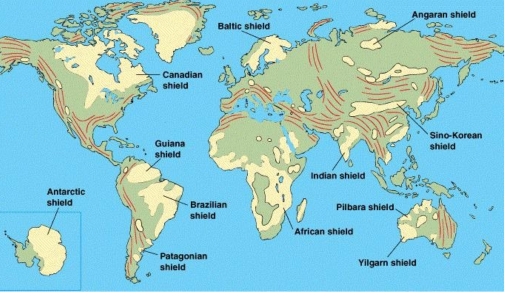
Each continent contains pieces of the Earth’s oldest crust referred to as shields
Cryptozoic Rocks
Importance of cryptozoic rocks:
1. major source of Cu, Cr, Au, Ag, Fe, Ni, U
2. Half of word metallic mineral resources
cryptozoic rocks characterized by:
1. lacking index fossils, except for some microscopic cyanobacterial fossils
2. are severely deformed, metamorphosed & deeply eroded

Cryptozoic Chronology
Sedgwick in Wales
The Canadian Shield
The chronology or dating of cryptozoic rocks was established by isotopes
Sedgwick in Wales
Sedgwick recognized clearly the relationships between older unfossiliferous rocks & fossiliferous early Paleozoic ones in Wales
Based on relationships between unfossiliferous & fossiliferous rocks Sedgwick named:
1. Azoic ‘no life’: first name for Precambrian
2. Eozoic & Archeozoic ‘ancient life’
3. Cryptozoic ‘obscure life’ was proposed After the fossils were found
The Precambrian-Paleozoic boundary
1. Precambrian rocks are more deformed & metamorphosed than the overlain Paleozoic
2. unconformity between 2 rock sequences
3. Lowest stratigraphic appearance of cambrian index fossils has defined boundary
4. today this boundary defined by isotopes
The Canadian Shield
Cryptozoic rocks first recognized in Britain, N-America, & Scandinavia
The cryptozoic rocks are most widely exposed in the stable continental Cratons or Shield
The shield concept comes out from the appearance of these rocks on the geologic map, while the shields are largely accidents of erosion where the stripping off of later deposits has exposed the ancient basement
Tectonic term Craton is more useful than shield because it defines the overall relative structural stability of a large portion of the earths crust through a long time regardless of the age of the rocks exposed there today

Interpretation of Crustal development from Sediments
The sources from which sedimentary rocks were derived are reflected by composition
Composition modified after deposition by
1. Climatic condition
2. Chemical changes
Type of sediments
1. Terrigenous clastic: derived from erosion of older rock, contain silicate such as quartz
2. Non-terrigenous: formed in aqueous depositional environments
– Chemically precipitated sediments, such as the evaporites & carbonate rocks composed of fossils skeletal or calcareous particles
Textural Maturity
Clastic textures reflect:
1. rates of physical sedimentary processes
2. intensities of sedimentary processes
Grain size or coarseness reflects the power of transporting agents
Transporting agents
1. Wind: moves only sand & silt
2. Moving water: carry sand, silt & gravel
3. Mudflows & Glaciers: carry sand, silt, gravel, large blocks for along distances due to grater density & viscosity
Grain Size decreases with time & distance of transport, Because
1. decreasing carrying power with distance
2. reduction of particle size by abrasion
Size Sorting: Range of sizes, depend on:
1. time of transport
2. constancy of physical energy of agents
Rounding of fragments is related to:
1. intensity & duration of abrasion
2. toughness of materials (clasts)
High abrasion & winnowing cause:
1. size of particles will be reduced
2. sorting of size will improve
3. rounding will increase
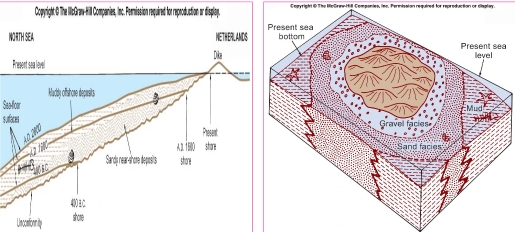
1. deposition of gravel near the source
2. well-sorted sand in other place, sea ward
3. well-sorted particles of fine silt & clay in a third place, more deep water

development of textural maturity of sand via abrasion & separation or sorting
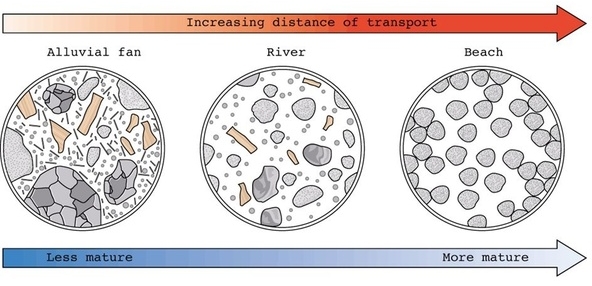

Compositional Maturity
Mineral composition of a clastic sediment will change as its particles are subjected to:
1. repeated physical crushing
2. chemical destruction of less stable mineral
Rock fragments tend to be ground down rapidly to their separate mineral grains
1. Dark minerals (pyroxenes & amphiboles) → rapid chemical breakdown
2. The more stable mineral will stay & reach the ultimate residue such as quartz, feldspar, some mica, & heavy mineral (such as zircon, garnet, magnetite)
Ultimate residue composition depend on:
1. Resistance of the original components
2. Abundance of the original components
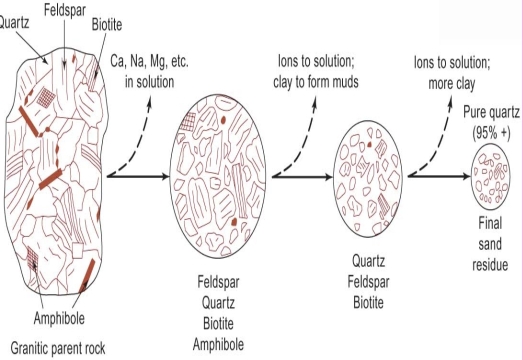
Less stable minerals are broken down both physically & chemically to leave a residue of most resistant mineral grains
Stratification
provides clues about depositional processes
Thin & horizontal lamination in very fine sediments
– formed by slow settling of clay & silt
– need a minimum of current agitation
– best environment: deep lake, sea bottom
Cross-stratification common feature of sands & fine gravels deposited by wind or water
Cross-stratification formed by moderately strong & turbulent traction currents that roll, bounce particles over a loose sediment surface corrugated by small-scale ripples or larger-scale dunes, Grains carried to the crests of the ripple or dune roll or slide down the steeper side, so resulting inclined cross-stratification reflects the steeper face of the migrated ripple or dune, & it dips toward the down current direction
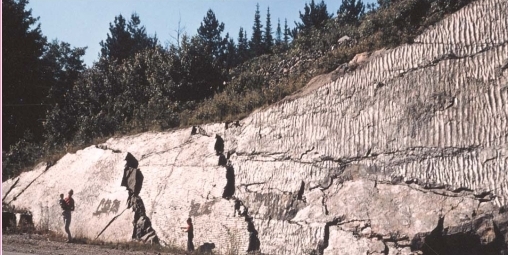
Ripples exposed on 3 different stratification planes: on middle surface perpendicular in trend to the others, indicating 90˚ shift of wave & current directions between times of deposition of strata

Grains roll & bounce over the dune crest, coming to rest on the steeper faces
Successive inclined or cross-stratification forms as the steeper face migrates, each lamina is a buried fossil steeper face

Sorting helps in determining the origin of an ancient sandstone, Ex. note great difference of sorting by surf & turbidity currents
Proterozoic Rocks Record
First 100Ma: no record is known due to
1. the surface was volcanic
2. intense bombardment by meteorites
3.9 Ga: local crustal blocks formed after
1. heat began to dissipate
2. large meteorite impacts ceased or stopped
4 – 2.5Ga: Oldest rocks, are 2 assemblages
1. Greenstone belts: metamorphosed-volcanic rocks, associated with sediments
– drives from dark, & green-colored minerals produced by metamorphism of mafic rocks
2. Gneiss belts: high-grade metamorphic
Relation between assemblages isn’t clear:
– First view: they differ only in degrees of metamorphism & reconstitution
– other:
1. Gneiss is remnants of incipient continents
2. greenstone remnants of oceans & volcanic arcs formed between continents
The Proterozoic sediments are:
1. Poorly sorted graywackes
2. Light-colored, & well-sorted pure quartz sandstones that show cross-strata, ripple mark
4. well-rounded quartz/chert pebble
3. limestone, contain stromatolites
stromatolites wavy laminated structure, formed by cyanobacteria

Ocean & Atmosphere
Archean rocks bear evidence of anaerobic early conditions, that was supported geologically by many clues, such as :
1. Sediments are dark-colored due to the presence of unoxidized carbon, fine iron sulfide FeS₂ & iron carbonate FeCO₃
2. Rocks contain several metals with affinities for O: Mn, Cu, Zi, U, & vanadium, which present widely in least oxidized state
3. Sulfur has an affinity for O but it present only in its unoxidized or reduced state in the pyrite FeS₂
4. Differences between sulfur isotopes in Archean & Proterozoic sediments were thought to reflect a contrast in atm O content
The Archean chemical sinks consumed any available early O, this was by oxidation of hydrogen H₂O & carbon CO₂
After these sinks were full saturated with O, S, Fe, & other metals begin to be oxidized, this was indicated by red color of oxidized iron & sulfur CaSO₄
It was inferred that this saturation occurred sometime after photosynthetic organisms appeared & began to release O₂ into atm
Appearance of widespread, red-colored strata “red beds” among Proterozoic rocks seemed to confirm a gradual accumulation of free O₂
Geologic evidence mentioned above cited or indicated that the Archean condition was aerobic, this view is fit to the biochemists, But some biologist argued that the free O₂ should be at the same time generated to the atm since the photosynthesis began, so they think that no need to one Ga which was suggested by geologist for the consumed O₂ by the chemical sinks
A growing number of geologist have challenged the slow-accumulation of free O₂ on the following ground :
1. The unoxidized C in Archean sediments may not be significantly different, either in total abundance or in isotopic makeup, from C in younger ones
2. Free C as well as Fe-sulfide & Fe-carbonate minerals have been preserved in O-poor muddy environments (such swamps) right up to the present day
3. Unoxidized Mn, Cu, Zn, vanadium, U although widely scattered, not very common in Archean sediments & like free C & Fe sulfide, might be explained by local anaerobic conditions of deposition
4. Some Archean red beds & oxidized sulfate evaporites have now been discovered, as well as some oxidized Archean soils
So. significant free O₂ existed even in the Archean atmosphere
Cryptozoic Climate
Evidence about cryptozoic climates is scant, but there is nothing that indicates conditions different from later geologic time
Chemical arguments suggest more atm CO₂, a condition that should have caused a warmer average global T (greenhouse effect) & more acidic rains
direct evidence of climatic extremes:
1. Evaporite deposits & mud cracks attest to dray & probably hot conditions sufficient to completely evaporite sea-water locally
2. Proterozoic wind deposits also are known, & they suggest large desert dune fields
3. Evidence of cold periods is even better known by glaciers deposits

rocks such as these, along with salt crystals, show that hot, dry conditions were common 1.8 Ga & that enough free O₂ was present in the atm to turn the sediments rusty red
Early Proterozoic Glaciation
As a strong indicator for cold conditions coming from sediments, were Gowganda Formation in Ontario show the following features of the sediments:
1. massive rock type
2. unstratified & unsorted large boulders, pebbles, sand, & fine clay surrounded by a fin matrix of dark material
3. laminated mudstone, resembles Pleistocene glacial lake clays containing laminae interpreted as seasonal layers, & some of layers contain scattered pebbles
4. at several localities where the surface is exposed, fine, parallel scratches are visible, which strongly resemble striations made by glaciers
All of these features which had been seen in the Gowganda Formation are direct clues for glaciers deposits or moraine
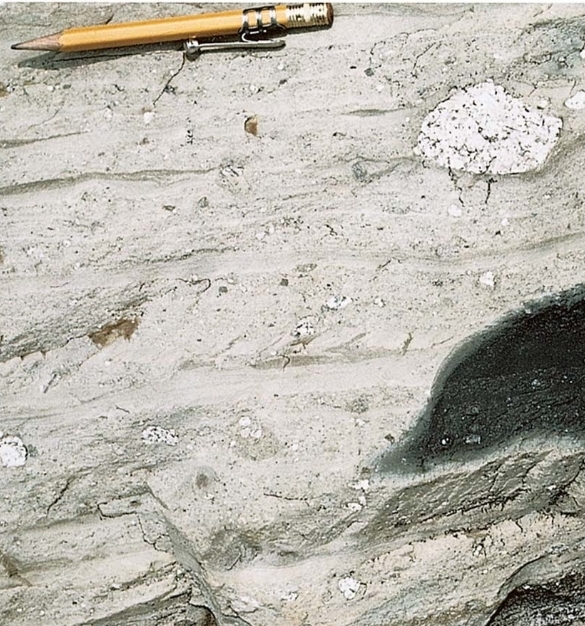
Association with glacial tills suggest dropping of sandstones from drifting icebergs
Late Proterozoic Glaciation
The end of the Proterozoic was marked by a great global glaciation event, the Varangian glaciation, which produced continental glaciers at nearly equatorial latitudes
The exact causes of this extraordinary glaciation are controversial, but the planet nearly became a lifeless frozen world, like Mars
When the Varangian glaciers retreated, multicellular life emerged for first time after nearly 3Ga of single-celled life on this planet
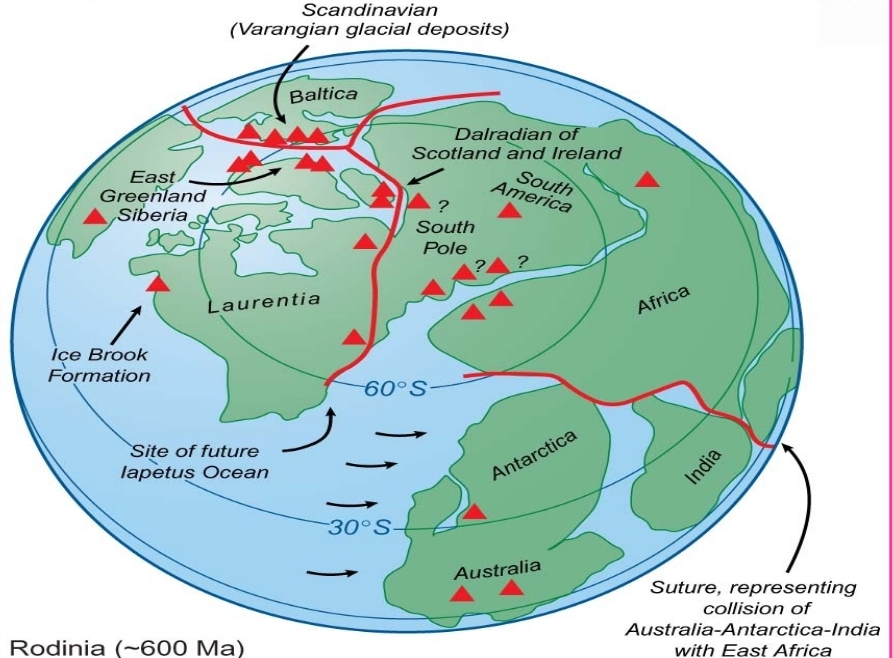
In some places, these glacial deposits are interbedded with marine limestone, further proving their low-latitude origin
Such evidence leads some scientists to suggest that the earth my have barely avoided freezing over completely in the Varangian
